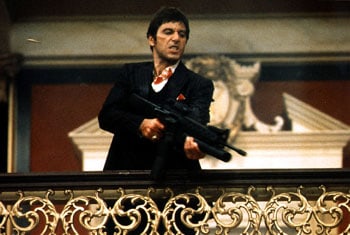What was really intended with this film? In a way, it’s about the rise and fall of a gangster. In another, it’s a portrait of a flawed man who has an unhealthy obsession with his sister, which reminds of some of Scorsese’s heroes. Then again, the film features some extremely violent action scenes that have nothing to envy to those from “Rambo”. Not to mention the documentary-style opening and the ‘80s fish-out-of-water comedy feel of some of the early scenes in which Pacino and his sidekick are trying to get some pussy. “Scarface” is all that at the same time and the sure thing is that, unbalanced as it may be, it’s an exhilarating picture.
The heart of the movie lies in Al Pacino’s unforgettable interpretation of Tony Montana, a Cuban punk who guns his way to the top of Miami’s cocaine world. Pacino first showed his exceptional talent as the cold and pitiless Michael Corleone in the Godfather trilogy, but it was just one side of his acting. With “Scarface”, Pacino shows that he can not only nail perfectly a Cuban accent and attitude, but also that he’s capable of riveting intensity and excess. The film has him growing more and more obsessed with control and money. He craves a girl who’s absolutely not for him, played by Michelle Pfeiffer in her first major role. And then there’s his disturbing need to protect his kid sister (Mary Elizabeth Mastrantonio). What’s the most striking is how, even after he achieves to get from ex-con immigrant dishwasher to millionaire hot shot, he doesn’t even seem satisfied. He’s snorting coke hysterically and scaring everyone out of his life. Bored and impatient, he doesn’t even notice how successful he’s become. As you can see, Tony Montana ain’t a simple man. He’s so messed up and complicated that it’s hard to see him as just a character in a movie, and Pacino is so darn convincing that you almost forget that it’s fiction.
The film was directed by a favorite of mine, Brian De Palma. It’s really different from most of his work, which is more often about carefully crafted set pieces à la Hitchcock. Films like “Carrie”, “Blow Out” or “Dressed to Kill” keep overwhelming you with style but for “Scarface”, De Palma seems to stand back a bit. The film still packs unforgettable scenes, but few visual tricks like the split screens or 360 degrees pans that De Palma usually love. Maybe it’s the influence of screenwriter Oliver Stone. We recognize his sense of political indignation in the way he portrays the American Dream which, according to this film, is more about greed, lies and corruption than hard work. There’s also the early scenes that claim that Fidel Castro sent thousands and thousands of his convicts in America in 1980 to take revenge. I’m not saying that this ain’t true, but I just think that’s it’s a pure Stone touch.
“Scarface” is an amazing film that transcends its genre roots to and achieves the devastating feel of a Shakespeare tragedy. The film’s only weakness is probably the music. I don’t have anything against cheesy ‘80s pop, but it hardly has its place in a dark and rough film like this. Still, that’s no biggy, and the film remains an always riveting picture with one of the most gripping screen performances I’ve ever seen and a breathtaking finale that predates and arguably outdoes the most ultra-violent and spectacular John Woo shoot-outs.

